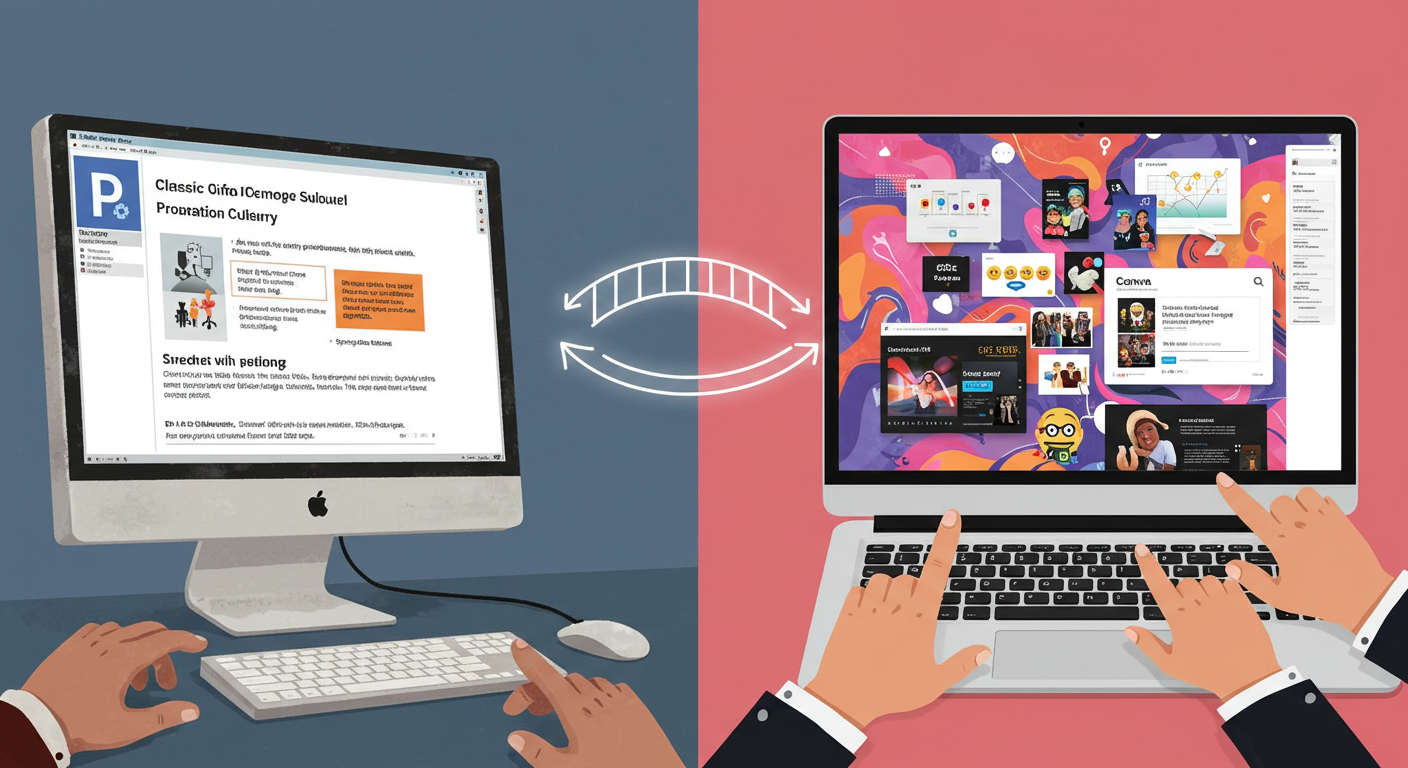PowerPoint was the go-to solution for pitches, presentations, and compelling narratives for years. Its bullet points, animations, and structured templates supposedly revolutionised how agencies conveyed their ideas with clarity, professionalism, and consistency.
However, step into any creative agency today, and you will discover a subtle resistance. Young creatives are moving away from PowerPoint and toward platforms such as Canva, Google Slides, Figma, and Notion. At first glance, it may seem to be an issue of convenience. Yet, this movement symbolises something deeper: a generational shift in how ideas are developed, exchanged, and marketed.
A New Kind of Creativity: Visual-First, Speed-Driven
Today’s youthful creatives grew up with Instagram grids, TikTok stories, Pinterest boards, and YouTube lessons. Consequently, they think visually. They prioritise velocity, clarity, and feel. Canva provides a simple, drag-and-drop platform with stylish templates, collaborative editing, and no formatting issues.
They compare PowerPoint to Windows XP: sluggish, highly organised, and unbearably corporate.
“I don’t have time to be aligning boxes and fighting with SmartArt,” says a 24-year-old strategist at a creative agency. “I just want to get the story out in a way that feels like us.”
Real-Time Collaboration Is a Must
More recent systems are team-oriented, in contrast to PowerPoint’s focus. There will be no more “v6_final_final_EDITED.pptx” mayhem, thanks to Google Slides and Canva’s real-time collaboration features.
Live communication is not only useful but vital in fast-paced organisations due to the rapid evolution of briefs and the tightness of deadlines.
The Democratisation of Deck Design
For years, PowerPoint stood as the go-to solution for pitches, presentations, and compelling narratives. Its bullet points, animations, and structured templates supposedly revolutionised how agencies conveyed their ideas. They achieved this with clarity, professionalism, and consistency.
However, step into any creative agency today, and you will discover a subtle resistance. Young creatives are moving away from PowerPoint. They now prefer platforms such as Canva, Google Slides, Figma, and Notion. At first glance, this may seem like an issue of convenience. Yet, this movement symbolises something deeper: a generational shift in how people develop, exchange, and market ideas.
A New Kind of Creativity: Visual-First, Speed-Driven
Today’s youthful creatives grew up with Instagram grids, TikTok stories, Pinterest boards, and YouTube lessons. Consequently, they think visually. They prioritise velocity, clarity, and feel. Canva provides a simple, drag-and-drop platform with stylish templates, collaborative editing, and no formatting issues.
They compare PowerPoint to Windows XP: sluggish, highly organised, and unbearably corporate.
“I don’t have time to be aligning boxes and fighting with SmartArt,” says a 24-year-old strategist at a creative agency. “I just want to get the story out in a way that feels like us.”
READ ALSO: You asked. Did they listen?
Real-Time Collaboration Is a Must
More recent systems are team-oriented. This contrasts with PowerPoint’s individual focus. Say goodbye to “v6_final_final_EDITED.pptx” mayhem. Google Slides and Canva’s real-time collaboration features eliminate it.
Live communication is not only useful but vital in fast-paced organisations. This is due to the rapid evolution of briefs and the tightness of deadlines.
The Democratisation of Deck Design
Decks were formerly considered holy territory. They were reserved for top strategists and designers. Now, however, everyone wants in. This includes clients, interns, account executives, and copywriters. With user-friendly tools, anyone can construct a visually appealing and effectively communicative deck.
This doesn’t mean that design isn’t important. Rather, people are integrating it into every role.
“You don’t need to be a designer to make a clean, effective presentation anymore,” says a creative director. “That’s both exciting and a little scary.”
The Cultural Gap: Structure vs. Flow
However, tension exists. Many seasoned workers still consider PowerPoint the gold standard for professionalism. What about Canva? Not serious enough. Slides on Google? Just not “elegant” enough. Agencies may emphasise perfection rather than performance. Younger teams see this as a barrier.
This battle is about more than just tools. It’s about creative flexibility, moving quickly, and being relevant.
It’s Not Laziness. It’s Efficiency
Some people think that young creatives use Canva just because they’re not interested in learning the traditional methods. Honestly, it really comes down to time and what you produce. They’d rather concentrate on the ideas instead of dealing with tricky formatting.
Clients care less about kerning and slide masters. They are more interested in originality and clarity.
The Bigger Picture: What This Shift Means
The tools that creatives pick say a lot about how their firm works. A strict, top-down deck method can stop great work in its tracks. An open and natural one encourages trying new things, working together, and having fun. To stay useful, agencies need to be open to change. This applies not only to how they talk to people but also to how they work together.
This doesn’t mean that PowerPoint is dead. Instead, it marks the rise of artistic freedom.
Slide culture has evolved. Young creatives are not taking shortcuts; they are simply finding a way to stand out in all the noise. Perhaps it’s time to let the deck reflect the vibe of the ideas it’s supposed to hold.
Decks were formerly considered holy territory, reserved for top strategists and designers. Now, however, everyone from clients to interns to account executives to copywriters wants in. With user-friendly tools, anyone can construct a visually appealing and effectively communicative deck.
This doesn’t mean that design isn’t important; rather, it’s being integrated into every role.
“You don’t need to be a designer to make a clean, effective presentation anymore,” says a creative director. “That’s both exciting and a little scary.”
The Cultural Gap: Structure vs. Flow
However, tension exists. For many seasoned workers, PowerPoint is still the gold standard when it comes to professionalism. What about Canva? Not serious enough. Slides on Google? Just not “elegant” enough. Agencies may be emphasizing perfection rather than performance, which younger teams see as a barrier.
This battle is more than just over tools. It’s about having creative flexibility, moving quickly, and being relevant.
It’s Not Laziness. It’s Efficiency
Some people think that young creatives use Canva just because they’re not interested in learning the traditional methods. Honestly, it really comes down to time and what you produce. They’d rather concentrate on the ideas instead of dealing with tricky formatting.
Clients are less concerned with kerning and slide masters; they are more interested in originality and clarity.
The Bigger Picture: What This Shift Means
The tools that creatives pick say a lot about how their firm works. A strict, top-down deck method can stop great work in its tracks. An open and natural one encourages trying new things, working together, and having fun. To stay useful, agencies need to be open to change, not only in how they talk to people but also in how they work together.
This doesn’t mean that PowerPoint is dead. Instead, it marks the rise of artistic freedom.
Slide culture has evolved. It’s not that young creatives are taking shortcuts; they’re just finding a way to stand out in all the noise. Maybe it’s time to let the deck reflect the vibe of the ideas it’s supposed to hold.
ALSO WATCH: MARKETING EDGE ONTV







Comment
No comments found.